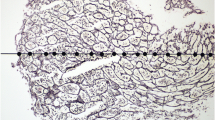Summary
Acridine orange (AO)-RNA fluorescence was studied histochemically in 9 normal human pituitary glands, in 26 secretory and nonsecretory pituitary adenomas, and in a dysgerminoma. Six adenomas showing immunoreactivity for prolactin showed intense orange-red cytoplasmic fluorescence; 6 other tumours exhibiting immunoperoxidase activity of growth hormone showed less intense AO-RNA fluorescence, and 5 adrenocorticotropic hormone-containing adenomas showed still weaker orange fluorescence. Among the chromophobe adenomas without immunoreactivity for secretory products, 5 had uniformly very weak AO-RNA fluorescence, while in 4 other a few scattered cells with strong AO-RNA fluorescence were detected among the majority of weakly fluorescent cells. The pituitary dysgerminoma contained many cells with strong AO-RNA fluorescence. Electron microscopy of these cases showed good correlation of cytoplasmic concentration of ribosomes with AO-RNA fluorescence of the adenomas. AO is useful as an inexpensive, simple supplementary stain for frozen or paraffin sections of pituitary tumours to infer secretory activity as a correlate of RNA concentration and to demonstrate a secretory potential in some cells of hormonally inactive tumours.
Similar content being viewed by others
References
Asa SL, Gerri BM, Singer W, Horvath E, Kovacs K, Smyth HS (1986) Gonadotropin secretion in vitro by human pituitary null cell adenomas and oncocytomas. J Clin Endocrinol Metab 62:1011–1019
Davis JRE, Lyman TC, Franklyn JA, Docherty K, Sheppard MC (1986) Triiodothyronine and diphenylhydantoin reduce prolactin messenger RNA levels in cultured rat pituitary cells as measured by cytoplasmic dot hybridisation. In: Müller EE, MacLeod RM (eds) Neuroendocrine perspectives, vol 5. Elsevier, Amsterdam, pp 271–273
Horvath E, Kovacs K (1986) Identification and classification of pituitary tumours. In: Cavanagh JB (ed) Recent advances in neuropathology, vol 3. Churchill Livingstone, Edinburgh, pp 75–93
Ishibashi M, Yamaji T, Tabaku F, Teramoto A, Fukushima T (1987) Secretion of glycoprotein hormone α-subunit by pituitary tumours. J Clin Endocrinol Metab 64:1187–1193.
Labrie F, Godbout M, Lagace L (1980) Mechanisms of action of hypothalamic hormones at the pituitary level. In: Motta M (ed) The endocrine funtions of the brain Raven Press, New York, pp 207–232
Lamberts SWJ (1984) Antimitotic actions of dopaminergic drugs on human pituitary tumors. In: Müller EE, MacLeod RM (eds) Neuroendocrine perspectives, vol 3. Elsevier, Amsterdam, pp 317–343
Landolt AM, Heitz PU (1986) Alpha-subunit-producing pituitary adenomas. Immunocytochemical and ultrastructural studies. Virchows Arch [A] 409:417–431
Martinez AJ, Lee a, Mossey J, Maroon JC (1980) Pituitary adenomas: clinicopathological and immunohistochemical study. Ann Neurol 7:24–36
McKeever PE, Laverson S, Oldfield EH, Smith BH, Gadille D, Chandler WF (1985) Stromal and nuclear markers for rapid identification of pituitary adenomas at biopsy. Arch Pathol Lab Med 109:509–514
Ridway EC, Klibanski A, Ladenson PW, Clemmons D, Beitins IZ, McArthur JW, Martorana MA, Zervas NT (1981) Pure alpha-secreting pituitary adenomas. N Engl J Med 304:1254–1259
Rigler R Jr (1966) Microfluorometric characterization of intracellular nuclei acids and nucleoproteins by acridine orange. Acta Physiol Scand [suppl] 67:267; 121 pp
Sarnat HB (1985) L'acridine-orange: un fluorochrome des acides nucléiques pour l'étude des cellules musculaires et nerveuses. Rev Neurol (Paris) 141:120–127
Sarnat HB (1989) Répartition de l'A.R.N. au cours de la migration neuronale dans les cerveaux normaux et dysplastiques en développement chez l'humain: étude a l'acridine-orange. Rev Neurol (Paris) 145:127–133
Sarnat HB, Curry B, Rewcastle NB, Trevenen CL (1986) Cytoplasmic RNA in nervous system tumours in children. A fluorochromic study using acridine orange. Can J Neurol Sci 13:31–41
Sarnat HB, Curry B, Rewcastle NB, Trevenen CL (1987) Gliosis and glioma distinguished by acridine orange. Can J Neurol Sci 14:31–35
Schmued LC, Swan LW, Sawchenko PE (1982) Some fluorescent counterstains for neuroanatomical studies. J Histochem Cytochem 30:123–128
von Bertalanffy L, Bickis I (1956) Identification of cytoplasmic basophilia (ribonucleic acid) by fluorescence microscopy. J Histochem Cytochem 4:481–493
Author information
Authors and Affiliations
Additional information
Supported by a research grant from the Alberta Children's Hospital Foundation, Calgary (HBS)
Rights and permissions
About this article
Cite this article
Sarnat, H.B., Garcìa, J.H. & Curry, B. Fluorescence histochemistry of RNA in human pituitary adenomas. Acta Neuropathol 78, 245–251 (1989). https://doi.org/10.1007/BF00687753
Received:
Revised:
Accepted:
Issue Date:
DOI: https://doi.org/10.1007/BF00687753




